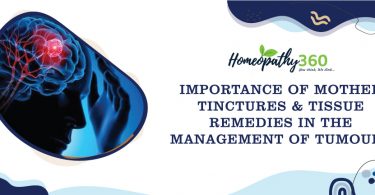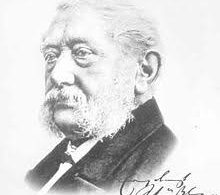
ABSTRACT: Irritant contact dermatitis is a common skin condition characterized by redness, inflammation, and itching caused by exposure to irritating substances. It is one of the most prevalent forms of contact dermatitis, affecting millions of people worldwide. Common causes include chemicals, allergens, and physical irritants such as friction and moisture imbalance. Symptoms typically manifest shortly after exposure and can range from mild to severe. This article deals with one such case of irritant contact dermatitis which shows promising results with Homeopathic medicine Sulphur as a constitutional remedy.
KEYWORDS: Homoeopathy, Irritant Contact Dermatitis (ICD), Modified Naranjo, Criteria, Constitutional Homoeopathic Medicine, Visual Analogue Scale, Sulphur,
INTRODUCTION: Irritant contact dermatitis is a prevalent skin condition that affects millions of people worldwide, having a global prevalence of 1.7–6.3%. 1 The skin serves as a protective barrier against the external environment, shielding the body from potential harm. However, when the skin comes into contact with certain substances that are irritating or damaging, it can lead to the development of irritant contact dermatitis. This condition can occur in people of all ages and backgrounds, and it may affect various parts of the body depending on the site of exposure.
Understanding the causes and risk factors associated with irritant contact dermatitis is crucial for its prevention and management. Various substances can act as irritants, including chemicals found in cleaning products, solvents, detergents, certain metals, and even allergens for individuals with heightened sensitivity. Physical factors such
as friction, pressure, and excessive moisture or dryness can also contribute to the development of irritant contact dermatitis.
Following are the signs and symptoms of irritant contact dermatitis.
SYMPTOMS SIGNS
The affected skin may become extremely itchy, leading to a strong urge to scratch and affected area may be painful or have a stinging sensation.
3: Redness, inflammation, itching, dryness and in severe cases, blistering or cracking of the skin. 3
Table 1- Signs and symptoms of Irritant Contact Dermatitis
DIAGNOSIS: Diagnosis made on the basis of history and clinical presentation. 2 Homoeopathy has good scope in treating cases of Contact Dermatitis including ICD, as homoeopathic remedies offer gentle and safe treatment for patients with ICD.
Homoeopathy treats the person as a whole with the help of individualization and determining the right remedy for the subject. 1 As well as it treats his pathological condition. The homeopathic medicines are selected after a full individualizing examination and case-analysis, which includes the medical history of the patient, physical and mental constitution, family history, presenting symptoms, underlying pathology, possible causative factors etc. A miasmatic tendency (predisposition/susceptibility) is also often taken into account for the treatment of chronic conditions 3
CASE REPORT:
A female patient named Mrs. XYZ, aged 45 years, House wife residing in the outskirts Bengaluru presented to the outpatient department of Government Homoeopathic Medical College and Hospital on 10.10.2022 with the complaints of
persistent rash on her hands, which is causing itching, redness, and discomfort. Patient was apparently healthy doing her house hold works, she regularly handles various cleaning agents and detergents and pesticides in her house and farms. She primarily noticed the rash after using a new pesticides solution in her farm two weeks ago. Initially, the rash was mild, but it has since spread and become increasingly bothersome. She has tried using over-the-counter hydrocortisone cream, but it provided only temporary relief.
Past history:
She has tried using over-the-counter hydrocortisone cream, but it provided only temporary relief.
No history of any other systemic illness.
Family history:
Father- died of old age
Mother- living healthy
Brother- 2 brothers Apparently healthy
Personal history:
Diet- Mixed
Appetite- Reduced
Thirst- Thirstless (1L/day)
Desire- Nothing specific
Aversion- Nothing specific
Micturition- 4-5 times/ day; 1time/ night
Bowel- Regular, Satisfactory.
Sleep- Refreshing
Dreams- Falling from height
Perspiration- Generalized, No odour, no staining
Thermals- Hot
Life Space Investigation:
Patient belongs to low socioeconomic status. She was the eldest child of the family; she had 2 brothers working as a farmer. Her father died because of old age and her mother living healthy. She studied till 7 th standard. She was hardworking and wants to do everything fast and perfect. She got married when she was too young. As her husband is also a farmer, she used to go with him and work in her own farm. She always wants to be occupied by some work, also wants to be with people and cannot stay alone. She usually maintains the house very neatly; she is religious and have her
own principles and belief. If other family members don’t follow her beliefs, she gets very angry and shouts at them. But, later on will feel bad about that. Always thinks regarding health of family members and pray for them. Recently she had a financial loss, was difficult to even arrange a day’s meal. All these miseries made her cry most of the time and think of ending her life. She attributes her symptoms to be developed after the use of new pesticide solution in her farm which gradually led to severe itching and dryness of hands.
General Physical examination:
No signs of pallor, cyanosis, clubbing, icterus, lymphadenopathy, oedema.
Nails- Pink.
Height-5 feet 7 inch.
Weight -60kg.
Tongue-Clean, moist.
Skin- Red, cracks on both hands with discharge of pus
Hair- Hair was dry and rough in texture.
Vital signs:
Temperature- Afebrile at the time of examination.
Pulse- 72 beats /min.
Respiratory rate- 18 cycles/ min.
Blood pressure- 122/80 mm Hg.
Systemic examination:
Respiratory system- NVBS audible, no added sounds
Cardiovascular system- S1, S2 heard, no murmur
GIT- Bowel sounds heard, per abdomen soft and tender
Local examination of skin;
Blisters+++
Redness+
Itching+++
Sticky discharge +
Occasional bleeding +
Evaluation of the case:
MENTAL
GENERALS
PHYSICAL
GENERALS
CHARACTERISTIC
PARTICULARS
Suicidal thoughts
Weeping
Angered easily
Reproaching oneself
Appetite reduced
Thirstless
Hot
Severe itching of skin
Discharge sticky+
Bleeding occasionally
> warm application
Table 2- Evaluation of the case
With the help of “The Chronic disease by Dr Samuel Hahnemann” 6 miasmatic evaluation for the presenting symptoms was done, which showed the predominance of Psoro-Syphilitic miasm. Considering the above symptomatology.
Repertorial totality:
- Mind: Suicidal disposition
- Mind: Weeping, tearful mood etc, Alone, when
- Sleep: Dreams: Falling: From high places:
- Skin: Cracks: Deep, bloody:
- Skin: Eruption: Discharge: Glutinous
- Skin: Itching: Voluptuous:
- Skin: Itching: Ameliorated from: Warmth
- Skin: Swelling: Crawling:
- Repertorial sheet:7
- Repertorial analysis:
- Sulphur: 11/6
- Merc – 9/5
- Puls – 6/4
- Sep – 6/4
- Petr – 5/2
Prescription:
RX: – Sulphur 1M × 1 dose (early morning empty stomach)
Rubrum (5-0-5) x 1 month
Auxiliary management:
Avoiding Direct contact of pesticides and detergent
Maintain hygeine
Applying coconut oil
Before treatment (10.10.2022)
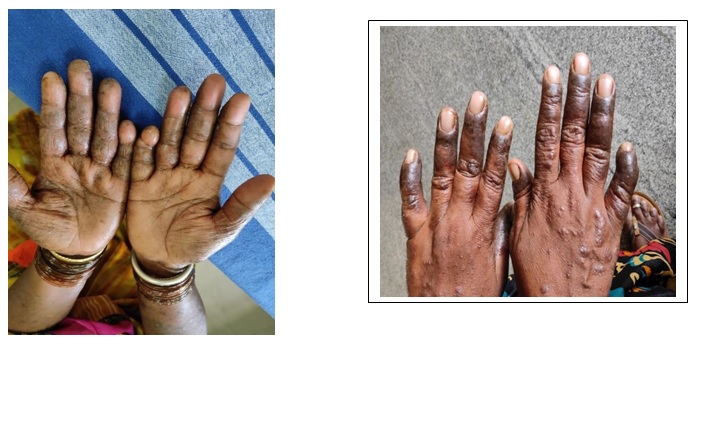
Image 2 – Before treatment

DISCUSSION:
Homoeopathy is a holistic system of medicine and here the treatment plan is based on individualization through the detailed case taking. It is essential to elucidate the constitutional makeup of the subject to select the single remedy with the help of totality of symptoms 3 . This case report of irritant contact dermatitis (ICD) treated with constitutional homoeopathic medicine is an attempt to show the efficacy of constitutional homoeopathic approach in the treatment of ICD without requiring medicated external application. In this case a single dose of Sulphur 1M chosen based on totality of symptoms has contributed to the overall improvement of the subject.
Improvement status was assessed with the help of visual analogue scale (VAS), VAS commonly used tool to measure the intensity of itch, it used in most of clinical trials as it featured with high reliability and validity. The left end point represents “no itch” and right end represents “worst imaginable itch” 4 . Also, here the changes in the casual attribution were assessed using Modified Naranjo Criteria (Table 4). Total score as per the criteria in this case is (+9) which is relatively close to the total of +13 which signifies the positive casual attribution of individualized homoeopathic remedy to the clinical outcome.
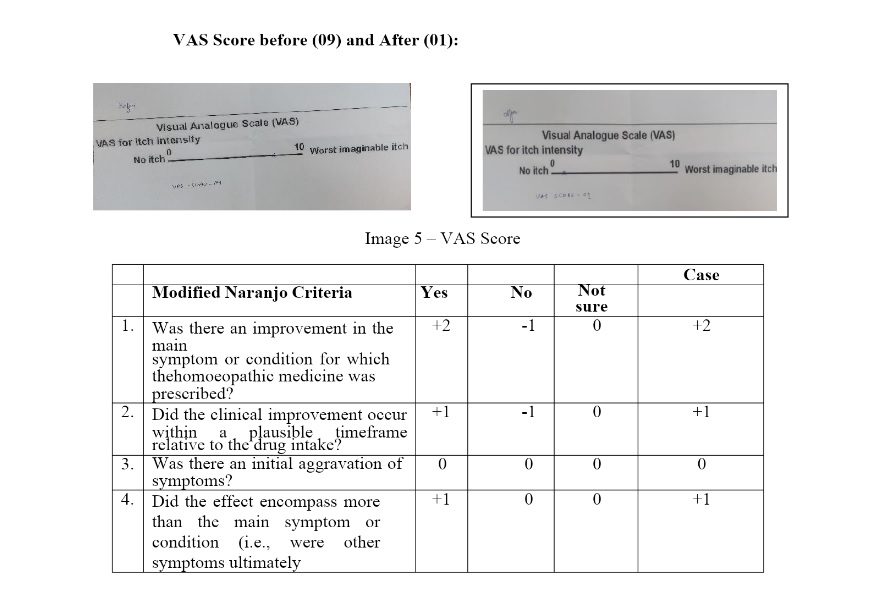
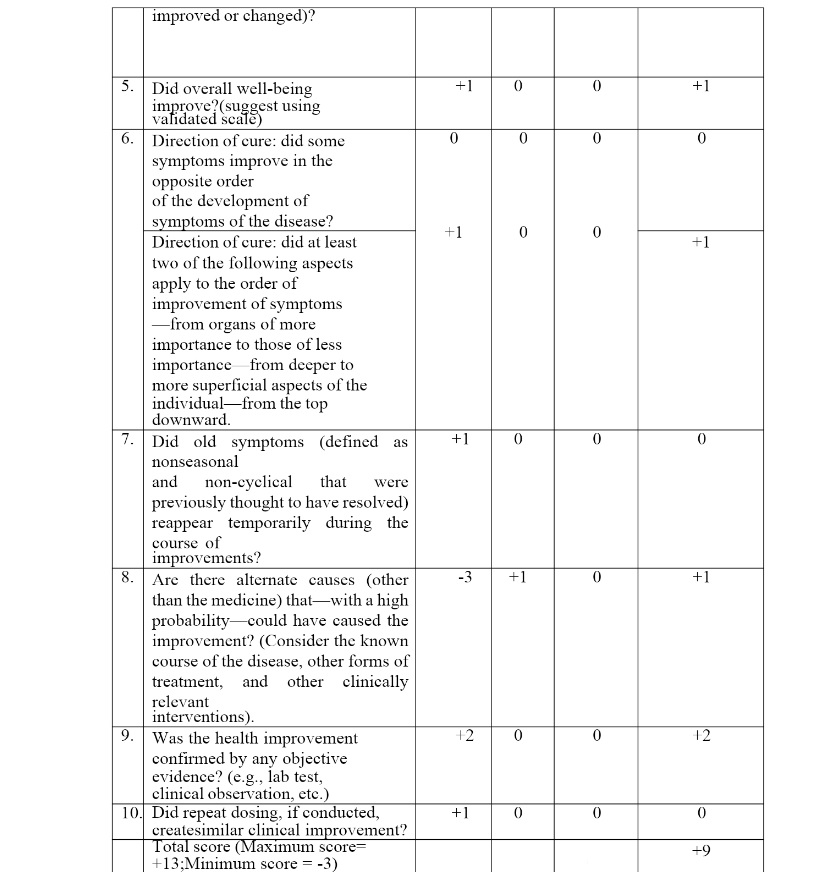
Table 3 – Assessment of Modified Naranjo Criteria Score
CONCLUSION:
This case study provides valid evidence of the successful treatment of ICD with the help of constitutional homoeopathic medicine based on an individuality of the subject. And it also signifies the importance of holistic approach of treatment in homoeopathy. The importance of internal medicine over the external applications has been demonstrates in this case. The single simple minimum dose of carefully selected constitutional homoeopathic remedy plays an important role in the treatment of ICD However, this is a single case report, additional research must be done that further makes this study useful
.
CONFLICT OF INTEREST: None
FINANCIAL SUPPORT: Not available
DECLARATION OF PATIENT CONSENT: Patient consent was taken for images to be reported for this article.
REFERENCE:
- Patel, A. and Ram, H. (2022) ‘Irritant contact dermatitis treated with
constitutional homoeopathic medicine – A case report’, Journal of Integrated
Standardized Homoeopathy, 5, pp. 24–29. doi:10.25259/jish_29_2021. - (No date a) (pdf) irritant contact dermatitis: Mechanisms to repair. Available
at:
https://www.researchgate.net/publication/276315660_Irritant_Contact_Dermatit
is_Mechanisms_to_Repair (Accessed: 11 July 2023). - About the Author: Dr. Manisha Bhatia Dr. (Mrs.) Manisha BhatiaBHMS and
BhatiaBHMS, Dr. (Mrs. ) M. (2020) Contact dermatitis – homeopathy treatment
and homeopathic remedies, Doctor Bhatia. Available at:
https://www.doctorbhatia.com/treatment/contact-dermatitis-homeopathy-
treatment-and-homeopathic-remedies/ (Accessed: 11 July 2023). - (No date) Visual Analogue Scale (VAS) [68] [Preprint].
doi:10.36425/rehab34231-22974. - Lamba, C.D. et al. (2020) ‘Evaluation of the modified naranjo criteria for
assessing causal attribution of clinical outcome to homeopathic intervention as
presented in case reports’, Homeopathy, 109(04), pp. 191–197. doi:10.1055/s-
0040-1701251. - Hahnemann S, Boericke W, Dudgeon R. Organon of medicine. 6th ed. New
Delhi: B. Jain Publishers; 2011. - RADAR Software: Frederick Schroyens Synthesis Repertory, Version 9.1
About the Author
Dr Ramya S J MD Part-1
Department of Practice of Medicine
Govt. Homoeopathic Medical College and Hospital, Bangalore-79
Email: [email protected]
UGO,
Dr. Veerbhadrappa C
PG Guide and Professor, Department of Practice of Medicine
Govt. Homoeopathic Medical College and Hospital, Bangalore-79



